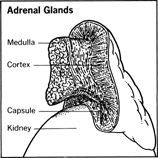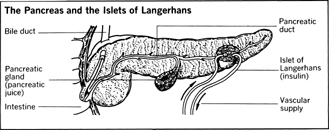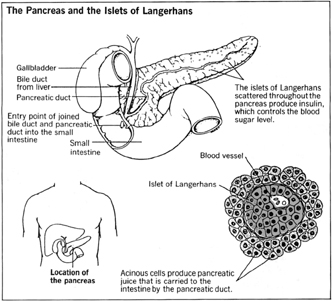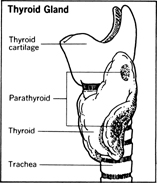The Endocrine Glands - The adrenal glands
Resting like skull caps on the top of both kidneys are the two identical adrenal glands . Each has two distinct parts, secreting different hormones.
Adrenaline
The central internal portion of an adrenal gland is called the medulla . Its most potent contribution to our body is the hormone adrenaline (also called epinephrine ). This is the hormone that, almost instantaneously, pours into our bloodstream when we face a situation that calls for extraordinary physical reaction—or keeps us going past what we think to be our normal limit of endurance.

A surge of adrenaline into the bloodstream stimulates our body to a whole array of alarm reactions—accelerating the conversion of stored foods into quick energy; raising the blood pressure; speeding up breathing; dilating the pupils of the eyes for more sensitive vision; and constricting the blood vessels, making them less vulnerable to bleeding.
Adrenaline provides a good example of the interdependence of the endocrine system. Its production stimulates the secretion of ACTH by the pituitary gland. And ACTH, as noted above, causes the adrenal cortex to accelerate production of its hormones. Some of these adrenal cortex hormones enable the body to call up the reserves of energy it does not normally need. For example, body proteins are not usually a source of quick energy, but in an emergency situation, the adrenal cortex hormones can convert them to energy-rich sugar compounds.
The Corticoids
There are some 30 different hormones, called the corticoids , manufactured in the adrenal cortex—the outer layer of the adrenal. A few of these influence male and female sexual characteristics, supplementing the hormones produced in the gonads. The others fall into two general categories: those that affect the body's metabolism (rate of energy use), and those that regulate the composition of blood and internal fluids. Without the latter hormones, for example, the kidneys could not maintain the water-salt balance that provides the most suitable environment for our cells and tissues at any given time.
Corticoids also influence the formation of antibodies against viruses, bacteria, and other disease-causing agents.
Extracts or laboratory preparations of corticoids, such as the well-known cortisone compounds, were found in the 1950s to be almost “miracle” medicines. They work dramatically to reduce pain, especially around joints, and hasten the healing of skin inflammations. Prolonged use, however, can cause serious side effects.
The Islets of Langerhans
Strewn at random throughout the pancreas are hundreds of thousands of tiny clusters of cells. Each of them, when seen under a powerful microscope, forms an “islet” of its own, similar to the other distinct islets, but markedly different from the pancreatic tissue surrounding it. These are the islets of Langerhans , named after the German scientist who first reported their existence in 1869. Each of these little cell clumps—up to two million or more of them—is a microscopic endocrine gland.


They secrete the hormone insulin , and the disease that occurs if they are not functioning properly is diabetes mellitus .
Actually, the islets of Langerhans produce not only insulin, but also a related hormone called glucagon . Both regulate the amount of sugar (glucose) that is present in the bloodstream and the rate at which it is used by the body's cells and tissues. Glucose supplies the energy for life and living processes.
When insulin and glucagon are not in sufficient supply, the cells’ ability to absorb and use blood sugar is restricted, and much of the sugar passes unutilized out of the body in urine. Because the body's ability to obtain energy from food is one of the very foundations of life, diabetes calls for the most careful treatment.
One of the great advances of twentieth century medicine has been the pharmaceutical manufacture of insulin and its wide availability to diabetics. With regulated doses of insulin, a diabetic can now lead a normal life. See Ch. 15, Diabetes Mellitus for a full discussion of this disease. The Thyroid Gland
The thyroid gland folds around the front and either side of the trachea (windpipe), at the base of the neck, just below the larynx. It resembles a somewhat large, stocky butterfly facing downward toward the chest.
Thyroxin
The thyroid hormone, thyroxin , is a complex protein-type chemical containing, along with various other elements, a large percentage of iodine. Like a number of other hormones manufactured by the endocrine glands, thyroxin affects various steps in the body's metabolism—in particular, the rate at which our cells and tissues use inhaled oxygen to burn the food we eat.

Hypothyroidism
A thyroid that is not producing enough thyroxin tends to make a person feel drowsy and sluggish, put on weight (even though his appetite is poor), and in general make his everyday activities tiresome and wearying. This condition is called hypothyroidism .
Hyperthyroidism
Its opposite—caused by too much secretion of thyroxin—is hyperthyroidism . A hyperthyroid person is jumpy, restless, and may eat hugely without gaining weight. The difference between the two extremes can be compared to environments regulated by two different thermostats, one set too high and the other set too low.
Although a normally functioning thyroid plays a significant part in making a person feel well, physicians today are less willing than in former years to blame a defective thyroid alone for listlessness or jittery nerves. Thirty or forty years ago it was quite fashionable to prescribe thyroid pills (containing thyroid extract) almost as readily as vitamins or aspirin; but subsequent medical research, revealing the interdependence of many glands and other body systems, made thyroxin's reign as a cure-all a short one.
Of course, where physical discomfort or lethargy can be traced to an underfunctioning thyroid, thyroxin remains an invaluable medicine.
Goiter
One disorder of the thyroid gland—the sometimes massive swelling called goiter— is the direct result of a lack of iodine in the diet. The normal thyroid gland, in effect, collects iodine from the bloodstream, which is then synthesized into the chemical makeup of thyroxin. Lacking iodine, the thyroid gland enlarges, creating a goiter. The abnormal growth will stop if iodine is reintroduced into the person's diet. This is the reason why most commercial table salt is iodized—that is, a harmless bit of iodine compound has been added to it.

Comment about this article, ask questions, or add new information about this topic: